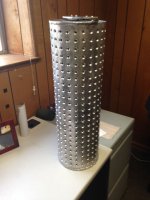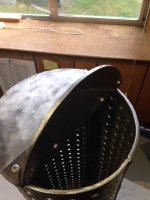Bardo
New member

 My friend (who is a metal worker) and I have finished the first prototype of the BBQ roasting drum. It is what you might call heavy duty, being made of 1/4 aluminum. Weighs about 7 lbs I think. Next step, getting grill and rotisserie pieces pulled together. Great excitement, and thanks to Buzzroaster for his generous guidance.
My friend (who is a metal worker) and I have finished the first prototype of the BBQ roasting drum. It is what you might call heavy duty, being made of 1/4 aluminum. Weighs about 7 lbs I think. Next step, getting grill and rotisserie pieces pulled together. Great excitement, and thanks to Buzzroaster for his generous guidance.

